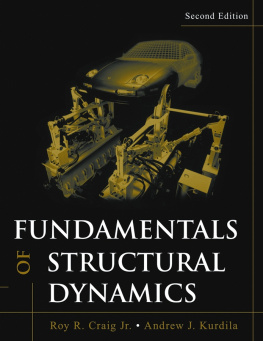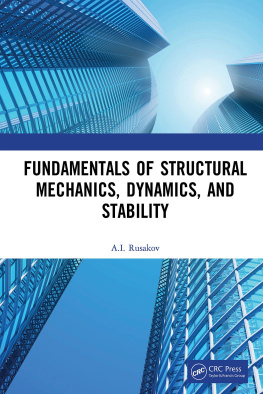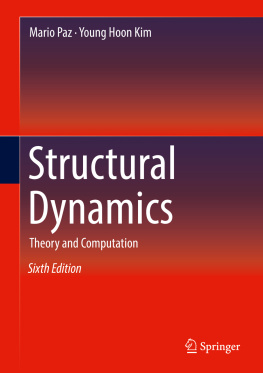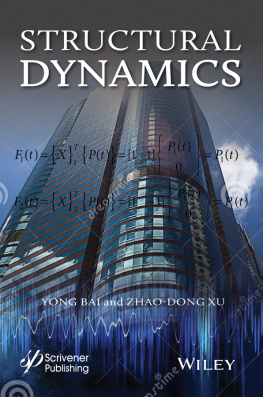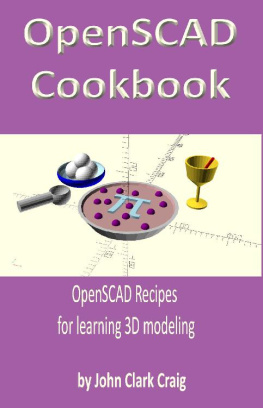Craig Roy R. - Fundamentals of Structural Dynamics
Here you can read online Craig Roy R. - Fundamentals of Structural Dynamics full text of the book (entire story) in english for free. Download pdf and epub, get meaning, cover and reviews about this ebook. year: 2011, publisher: Wiley, genre: Children. Description of the work, (preface) as well as reviews are available. Best literature library LitArk.com created for fans of good reading and offers a wide selection of genres:
Romance novel
Science fiction
Adventure
Detective
Science
History
Home and family
Prose
Art
Politics
Computer
Non-fiction
Religion
Business
Children
Humor
Choose a favorite category and find really read worthwhile books. Enjoy immersion in the world of imagination, feel the emotions of the characters or learn something new for yourself, make an fascinating discovery.
- Book:Fundamentals of Structural Dynamics
- Author:
- Publisher:Wiley
- Genre:
- Year:2011
- Rating:4 / 5
- Favourites:Add to favourites
- Your mark:
- 80
- 1
- 2
- 3
- 4
- 5
Fundamentals of Structural Dynamics: summary, description and annotation
We offer to read an annotation, description, summary or preface (depends on what the author of the book "Fundamentals of Structural Dynamics" wrote himself). If you haven't found the necessary information about the book — write in the comments, we will try to find it.
Fundamentals of Structural Dynamics — read online for free the complete book (whole text) full work
Below is the text of the book, divided by pages. System saving the place of the last page read, allows you to conveniently read the book "Fundamentals of Structural Dynamics" online for free, without having to search again every time where you left off. Put a bookmark, and you can go to the page where you finished reading at any time.
Font size:
Interval:
Bookmark:


Copyright 2006 by John Wiley & Sons, Inc. All rights reserved.
Published by John Wiley & Sons, Inc., Hoboken, New Jersey Published simultaneously in Canada.
No part of this publication may be reproduced, stored in a retrieval system, or transmitted in any form or by any means, electronic, mechanical, photocopying, recording, scanning, or otherwise, except as permitted under Section 107 or 108 of the 1976 United States Copyright Act, without either the prior written permission of the Publisher, or authorization through payment of the appropriate per-copy fee to the Copyright Clearance Center, Inc., 222 Rosewood Drive, Danvers, MA 01923, 978-750-8400, fax 978-646-8600, or on the web at www.copyright.com. Requests to the Publisher for permission should be addressed to the Permissions Department, John Wiley & Sons, Inc., 111 River Street, Hoboken, NJ 07030, (201) 748-6011, fax (201) 748-6008.
Limit of Liability/Disclaimer of Warranty: While the publisher and author have used their best efforts in preparing this book, they make no representations or warranties with respect to the accuracy or completeness of the contents of this book and specifically disclaim any implied warranties of merchantability or fitness for a particular purpose. No warranty may be created or extended by sales representatives or written sales materials. The advice and strategies contained herein may not be suitable for your situation. You should consult with a professional where appropriate. Neither the publisher nor author shall be liable for any loss of profit or any other commercial damages, including but not limited to special, incidental, consequential, or other damages.
For general information on our other products and services please contact our Customer Care Department within the U.S. at 877-762-2974, outside the U.S. at 317-572-3993 or fax 317-572-4002.
Wiley also publishes its books in a variety of electronic formats. Some content that appears in print, however, may not be available in electronic format.
Library of Congress Cataloging-in-Publication Data:
Craig, Roy R., 1934
Fundamentals of structural dynamics / by Roy R. Craig, Jr. and Andrew J. Kurdila.2nd ed. p. cm.
Rev. ed. of: Structural dynamics, c1981. Includes bibliographical references and index. ISBN 13: 978-0-471-43044-5 ISBN 10: 0-471-43044-7 (cloth)
1. Structural dynamicsData processing. 2. Structural dynamicsMathematical models. I. Kurdila, Andrew. II. Craig, Roy R., 1934-. Structural dynamics. III. Title.
TA654.C72 2006
624.1' 71dc22
2005043679
The first author dedicates his work on this edition to his grandchildren:
Talia, Kyle,and Hart Barron,and Alex, Brandon,and Chase Lemens.The second author dedicates his work to his wife, Jeannie, and to his children:
Patrick, Hannah, and Justin.
Preface to Structural DynamicsAn Introduction to Computer Methods
The topic of structural dynamics has undergone profound changes over the past two decades. The reason is the availability of digital computers to carry out numerical aspects of structural dynamics problem solving. Recently, the extensive use of the fast Fourier transform has brought about even more extensive changes in structural dynamics analysis, and has begun to make feasible the correlation of analysis with structural dynamics testing. Although this book contains much of the material that characterizes standard textbooks on mechanical vibrations, or structural dynamics, its goal is to present the background needed by an engineer who will be using structural dynamics computer programs or doing structural dynamics testing, or who will be taking advanced courses in finite element analysis or structural dynamics.
Although the applications of structural dynamics in aerospace engineering, civil engineering, engineering mechanics, and mechanical engineering are different, the principles and solution techniques are basically the same. Therefore, this book places emphasis on these principles and solution techniques, and illustrates them with numerous examples and homework exercises from the various engineering disciplines.
Special features of this book include: an emphasis on mathematical modeling of structures and experimental verification of mathematical models; an extensive introduction to numerical techniques for computing natural frequencies and mode shapes and for computing transient response; a systematic introduction to the use of finite elements in structural dynamics analysis; an application of complex frequency-response representations for the response of single- and multiple-degree-of-freedom systems; a thorough exposition of both the mode-displacement and mode-acceleration versions of mode superposition for computing dynamic response; an introduction to practical methods of component-mode synthesis for dynamic analysis; and the introduction of an instructional matrix algebra and finite element computer code, ISMIS (Interactive Structures and Matrix Interpretive System), for solving structural dynamics problems.
Although the emphasis of this book is on linear problems in structural dynamics, techniques for solving a limited class of nonlinear structural dynamics problems are also introduced. On the other hand, the topic of random vibrations is not discussed, since a thorough treatment of the subject is definitely beyond the scope of the book, and a cursory introduction would merely dilute the emphasis on numerical techniques for structural dynamics analysis. However, instructors wishing to supplement the text with material on random vibrations will find the information on complex frequency response to be valuable as background for the study of random vibrations.
A primary aim of the book is to give students a thorough introduction to the numerical techniques underlying finite element computer codes. This is done primarily through "hand" solutions and the coding of several subroutines in FORTRAN (or BASIC). Use of the ISMIS computer program extends the problem-solving capability of the student while avoiding the "black box" nature of production-type finite element codes. Although the ISMIS computer program is employed in Chapters 14 and 17, its use is by no means mandatory. The FORTRAN source code and a complete User's Manual for ISMIS are available for a very nominal fee and can be obtained by contacting the author directly at The University of Texas at Austin (Austin, TX 78712).
Computer graphics is beginning to play an important role in structural dynamics, for example, in computer simulations of vehicle collisions and animated displays of structural mode shapes. One feature of this book is that all figures that portray functional representations are direct computer-generated plots.
The text of this book has been used for a one-semester senior-level course in structural dynamics and a one-semester graduate-level course in computational methods in structural dynamics. The undergraduate course typically covers the following material: Chapters 1 through 6, Sections 9.1, 9.2, 10.1, 10.2, 11.1 through 11.4, and Chapter 12. The graduate course reviews the topics above (i.e., it assumes that students have had a prior course in mechanical vibrations or structural dynamics) and then covers the remaining topics in the book as time permits. Both undergraduate and graduate courses make use of the ISMIS computer program, while the graduate course also includes several FORTRAN coding exercises.
Portions of this text have been used in a self-paced undergraduate course in structural dynamics. This led to the statements of objectives at the beginning of each chapter and to the extensive use of example problems. Thus, the text should be especially valuable to engineers pursuing a study of structural dynamics on a self-study basis.
Font size:
Interval:
Bookmark:
Similar books «Fundamentals of Structural Dynamics»
Look at similar books to Fundamentals of Structural Dynamics. We have selected literature similar in name and meaning in the hope of providing readers with more options to find new, interesting, not yet read works.
Discussion, reviews of the book Fundamentals of Structural Dynamics and just readers' own opinions. Leave your comments, write what you think about the work, its meaning or the main characters. Specify what exactly you liked and what you didn't like, and why you think so.

